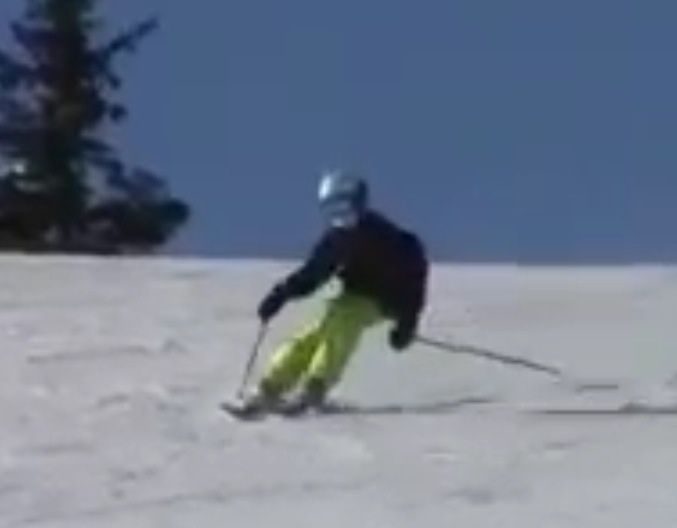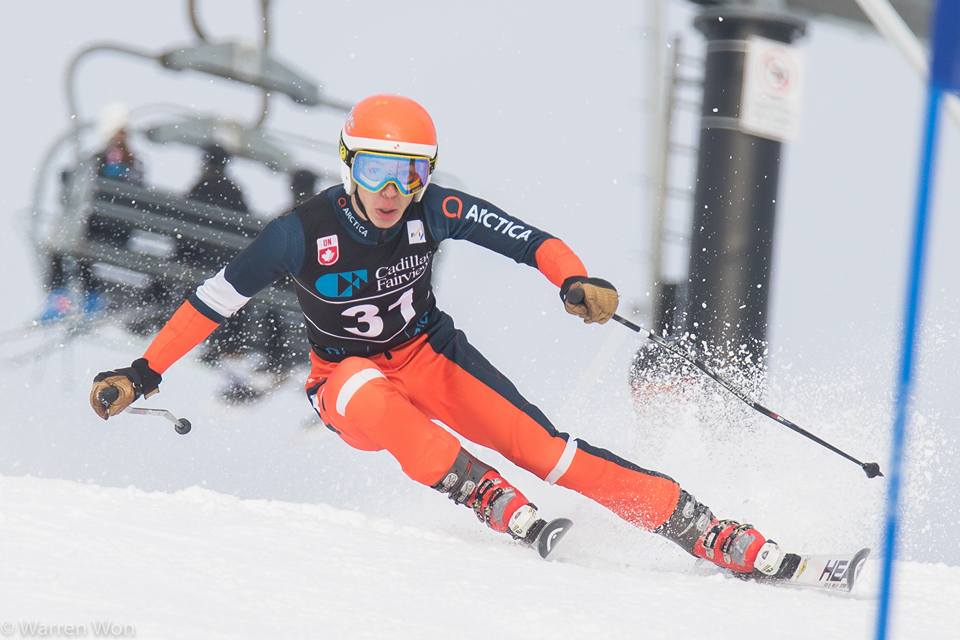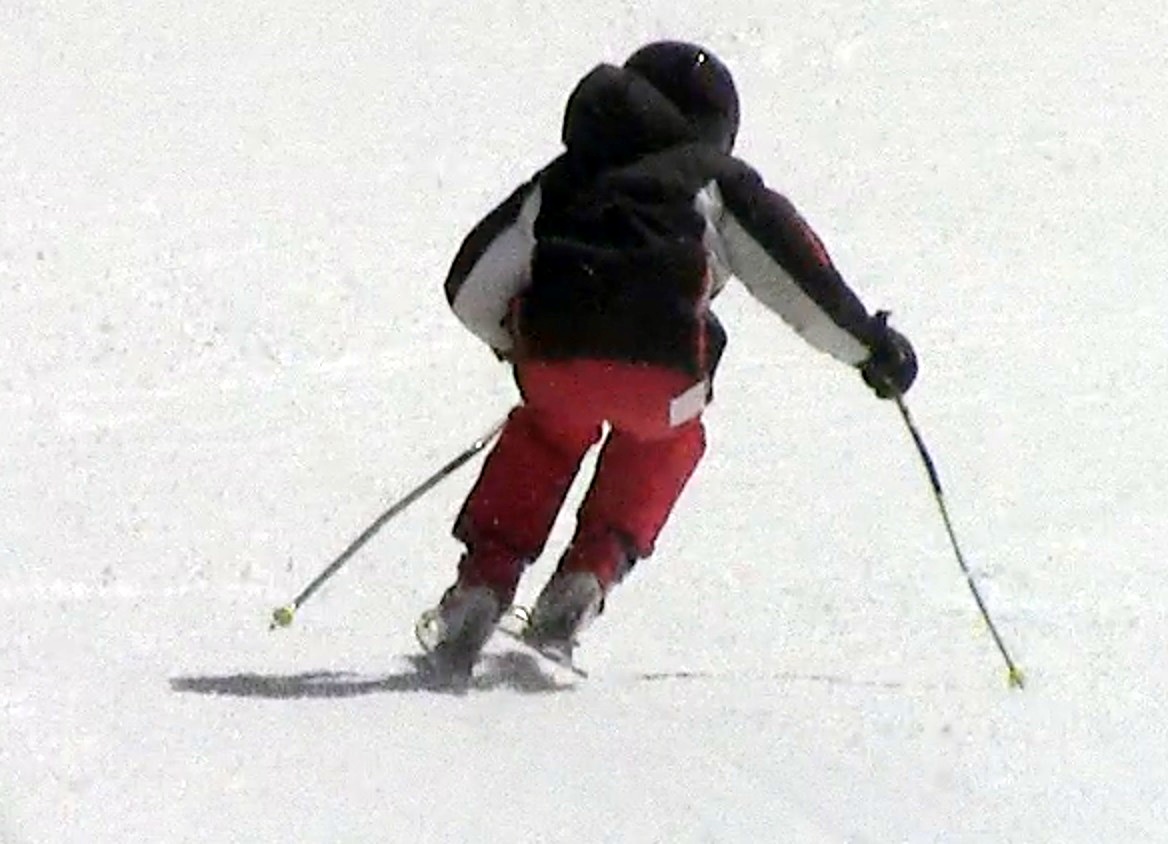Racers carve too much
Subscribe
Pub
Share
I hear this message fairly frequently, from the facilitators running an instructor course, for example, to the "Joe" in the lift line and a lot from coaches and instructors. The message is basically that racers carve too much and they need to learn to steer and pivot the skis. While learning some of the "softer skills" cannot easily raise an argument, claiming they can't pivot is wrong, let's dive in!
In my opinion, that message misses the mark! First of all, most ski racers don't actually carve with any skill, they just rail the skis around and call that carving, and... while I guess that does theoretically classify as carving, is not really carving, ok? It's just railing the skis around, "riding the sidecut" at very low edge angles, with no control over the turn shape.
Stemming to perfection
At one point, I participated in a coaching event, where we were taught how to use the snow plow, apparently to allow the racers to slow down practice and study the "edge engagement" at the top of the new turn, in the context of the C turn shape.
The reason given for that approach was that "most racers grind the bottom of the turn and they need to stop grinding"! I fully agree with that observation - but the solution they found, to study the turn doing pizzas is completely the wrong way to go about it: to open the new outside ski in a stem, the skier has to brace against and step off of the old outside ski, which is exactly what grinding the bottom of the turn is ! Talk about misunderstanding skiing and coaching it: that simply reinforces the same movement pattern that got them in trouble in the first place!
It doesn't teach a lot of balance either, as the skier still braces onto the long outside leg while stepping onto the new ski, while the actual skill required for a clean engagement of the skis is Soft balance++, not stemming and not attempting to feel the snow with a skidding boot.
Likely, the source for that was either (less likely) Warren Witherrel's classic progression for straight skis (from stem to release to carve) or, more likely, a recent video from Mikaela Shiffrin, practicing while hitting snow after injury, where she does a small stem for a few turns.
That's not necessarily an issue if coached properly to good skiers, but it's one of the reasons Why the snow plow is bad and one should be very careful, especially if using it with beginners!
There are so many other ways to slow down the practice and study the engagement at the top of the turn, especially the release drills and short turn practice etc. To focus on the top of the turn, again, the release drills are fabulous, although largely unknown. Also, any kind of focused short turn practice and slow focused technical skiing like you see above in Mikaela's video, are great! Not the pizza!
Conventional wisdom
Get your thoughts back to the racers riding the sidecut that we started with, a while ago... from here though, conventional wisdom concludes that they cannot control the turn shape at all and that the best course of action is to teach them some skidding and shmearing and help them get some variety in their skiing, so they can go down tight courses, too.
It has however been my observation that all these skiers can shmear and skid and steer around happily and survive tight courses slowly, but without issues... and while, indeed, working on short turns is a great idea, this type of thinking just denotes a lack of skill and knowledge from the coach. These skiers will continue to have only two modes: "railing" and "shmearing".
For an instructor, having to deal with someone for only the fabled one hour lesson and seeing as they either rail the skis on greens and pivot forceful Z turns on blues and black runs and from there, concluding that they need some short brushed turn practice, it is absolutely normal and the right thing to do.
Racing
However, for a race coach to conclude that because the racers can't control the edging and can't tighten the radius sufficiently, the only remedy is focusing on shmearing the turns and would keep teaching the two extremes, only denotes a lack of skill and knowledge from the coach.
In coaching racers, I emphasize that when free-skiing they must never reduce speed by a skidding action of their skis. Every time they do this they reinforce muscular habits related to skidding turns. How The Racers Ski, Warren Witherrel, 1972
This is what one of the great coaches, Warren Witherrel - founder of the Burke Mountain Academy, had to say and there is a lot of wisdom in that little paragraph. Once skidding becomes a crutch to get out of "tight spots", the racer will always default to that crutch when the going gets tough and he or she will never be able to progress to his or her full potential.
Here's a quick story, at one U19 race where I set a GS course, as coaches do, I purposefully set a few tricks and one was a big offset (tight turn) as the racers were coming off a steeper section, with a lot of speed. While talking to racers, the one coach next to me was reminding them over the radio "and remember the blue gate on the flats, control your speed going into it and steer nicely around it, so you can make it". He was stunned when it was my turn "as you come on the blue gate, hip to snow, dig in hard early because it will hold and carry the speed across the hill" - which most of the team was able to do... and we got some good results that run! And no, I don't think anybody crashed that day... although quite a few were thrown off by that gate.
Which of these two types of racers do you think can move on to whatever their "next level" is?
The big problem that I have with this type of conventional thinking is that it usually lacks technical focus. Technique is not mixing railing and steering - technique is knowing how to ski, refinement, balance and full control of the ski, whether carving or skidding! How to carve properly, how to brush turns effectively, how to release, engage and full control over the blending of these outcomes etc.
So... how do we get an athlete from railing low angles to full control of carved turns in any terrain? That's the thousand-dollar question, isn't it? But first...
Skidding, shmearing and brushing
Of course, brushing and shmearing turns are normal and effective and a skill that should be practiced with a fair amount of dedication, by all skiers. There are plenty of drills and environments for this:
- setting tight courses
- thousand turn competitions
- braquage
- short turn practice
- release drills and other drills
- bumps
- etc
Let's assign a more specific meaning to the terms we're using, so we can use them with more precision:
- skidding is the general concept of not carving, where the ski is skidding over the snow.
- shmearing - denotes perhaps a more skillful skidding of the skis
- brushing, we use this specifically to mean a shmearing that involves good technique (i.e. no pivoting or minimal foot steering), often, we use the notion of Brushed carving.
- redirecting - it's a slight (or not so slight) redirection of the ski when light, at the top of the turn, normal for adjusting line in a course and done with varying the timing of extension and tipping, not with pivoting the foot - which at high edge angles is impossible
- carving - we don't refer to carving as only the 100% "edge locked" variety, but the last 5% or 10% or so just before that. The definition of edge locked is much too narrow to be useful, depending on the condition of the snow, the timing of the turn, the athlete's... well, athletism etc. We're looking at high-performance skiing here, so see At high edge angles for more insight!
It matters how much you shmear and, more importantly: how you shmear!! If you're interested to learn more about the nuances here, see Oversteering.
I don't agree with resorting to pivoting to complement "carving" when the going gets tough!
And perhaps more importantly: brushing with good technique is perfectly fine, in fact great practice and a great way to slow down the turn, speed up the line when you can chop some off etc. But just blunt pivoting is not. Spend time studying and teaching specific technique, don't just go "refine it like this" which only works on a tiny minority that get it by mistake, not because they were taught.
Basically don't put the ski there but make it go there - that is true ski control. Often, we use the notion of Brushed carving to drive the point home.
Why is skidding less interesting for racing, than carving? Many reasons:
- getting impulse
- changing direction
- applying force
- using attention
- speed control
Impulse and direction
The better the ski engagement, the more force and angles can be applied, resulting in more ski bending and tighter turning and stronger impulse across and/or down the hill. But that's just racing terminology... what that means in plain English is that when the ski is skidding, you can't apply too much force to it, as it will skid away and you're out of balance. When the ski is engaged fully and carving, more angles and more pressure is available, meaning higher speeds and tighter turns.
Does this mean that the ski must be always fully engaged? No, but the sooner it is engaged, the sooner you can apply force, resulting in direction and impulse.
Control and brainpower
A skidding ski, by its nature, is more imprecise and requires more attention and brainpower than a carving ski. Once the ski is engaged, the skier has a lot more balance and options, which is why coaches generally insist on establishing a platform first, i.e. an engaged edge that you can balance on. These are basic racing and performance skiing principles from times immemorial...
...and more, that we get into in our racing level.
So... when are these relevant? I mean: skidding, shmearing etc? Of course, not all turns can be carved and racers have to employ all sorts of techniques, from full-on stivot to redirecting the skis while light, to just brushing the top of the turn, feathering the ski into engagement just a tad later, to either reduce the speed, radius, chop off some of the line etc.
Those are tactical decisions that the racer can take ahead of any turn and execute with more or less skill but the point is that these should not become the crutch, the default, the "go-to" move when the going gets tough. Or rather, how far can you push it before you have to resort to these. And that takes carving skill. That is and has been for a long time, the one skill that coaches should focus on: good technique.
This is so well said, that it bears repeating:
In coaching racers, I emphasize that when free-skiing they must never reduce speed by a skidding action of their skis. Every time they do this they reinforce muscular habits related to skidding turns. How The Racers Ski, Warren Witherrel, 1972
So... what do we do?
I'll stop my rant here, but... so... what to do?
Number one: refine short turns skill. Of course. But not the way you're maybe thinking of doing, with pivots and stems - that just promotes the lack of skill so pervasive at the lower levels. Use an OFR - the One footed release++ or uphill foot release - probably the best drill ever invented for ski mastery. Do it every day, together with the other release drills !
But, above all, refine carving skill. High-performance carving skill is based not on forcefulness, railing and grinding, but on a soft approach, relaxation, tipping and big angles with real balance and a complete control of the High-C, the top of the arc. And that takes a lot of knowledge, good mental models as opposed to inefficient mental models and a ton of very Deliberate Practice.
In a word, or rather one thousand words... this:
Reviewing expert effective technique for racing and teach and refine good technique, until the skiers own it. It is very slow and annoying practice, but well worth it. Also, think hard next time about Developing good mental models for ski racing which should be the main focus of the coach!
Here is the skier railing it in the first screenshot, improving in those early years:
Some drills or interest:
P.S.
Yes, I have actually attended that instructor course where "that guy" said that racers are bad skiers because they "can only carve" and, of course, he can fix them by teaching them "better" pivoting, as I'm sure many coaches have.
Yes, I also see young racers struggle to control the skis and just rail them around, daily. Maybe "that guy" wasn't wrong, after all? Your Mileage May Vary should be a standard disclaimer on any bit of instruction, anywhere! At least we're trying to give you the best bits of ski instruction we've found, on this website.
Good luck!
See more in: carving-blog Subscribe You need to log in to post a comment! There's 2 comment(s)...
The idea that racers carve all/most turns in GS is nonsense. If you watch the World Cup GS most of the turns are not pure carved, there is nearly always at least some skidding/shmearing/brushing/drifting going on with the exception of the 'flat' parts of the course. The top coaches know this only too well; many lesser coaches don't.
Indeed, I think it's fairly easy to see the percentages of turns edge-locked carved versus not, as well as what sections etc, on any given video and that any coach should watch as much of high-level racing video as possible... and while the why and where is a good discussion on its own, looking at the athletes, courses, tactics etc... this is a good point to bring up.
The WC racing is the pinnacle of racing and those courses are not set to be a walk in the park. The fact that regularly, 30% or more of the best 60-80 racers in the world fail to even complete these courses should say something about them.
Even the lower regional level courses are very tough, for that level, with 50% of the strongest regional racers failing to make it to the bottom, regularly.
That 50 % that failed though, didn't fail because they couldn't make it all the way down, from hockey stop to hokey stop, but because they refused to do that and instead, kept carrying speed and looking for deflection! And that's why next time, they may make it a little further, a little faster!!



